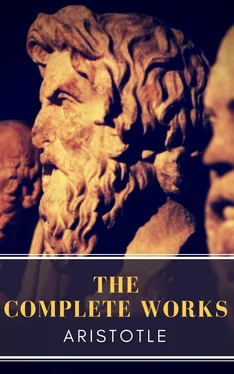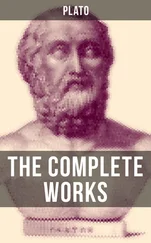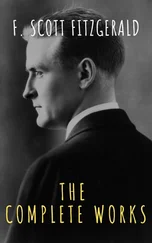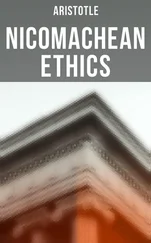Aristotle Aristotle - Aristotle - The Complete Works
Здесь есть возможность читать онлайн «Aristotle Aristotle - Aristotle - The Complete Works» — ознакомительный отрывок электронной книги совершенно бесплатно, а после прочтения отрывка купить полную версию. В некоторых случаях можно слушать аудио, скачать через торрент в формате fb2 и присутствует краткое содержание. Жанр: unrecognised, на английском языке. Описание произведения, (предисловие) а так же отзывы посетителей доступны на портале библиотеки ЛибКат.
- Название:Aristotle: The Complete Works
- Автор:
- Жанр:
- Год:неизвестен
- ISBN:нет данных
- Рейтинг книги:3 / 5. Голосов: 1
-
Избранное:Добавить в избранное
- Отзывы:
-
Ваша оценка:
- 60
- 1
- 2
- 3
- 4
- 5
Aristotle: The Complete Works: краткое содержание, описание и аннотация
Предлагаем к чтению аннотацию, описание, краткое содержание или предисловие (зависит от того, что написал сам автор книги «Aristotle: The Complete Works»). Если вы не нашли необходимую информацию о книге — напишите в комментариях, мы постараемся отыскать её.
This edition has been professionally formatted and contains several tables of contents. The first table of contents (at the very beginning of the ebook) lists the titles of all novels included in this volume. By clicking on one of those titles you will be redirected to the beginning of that work, where you'll find a new TOC that lists all the chapters and sub-chapters of that specific work.
Aristotle: The Complete Works — читать онлайн ознакомительный отрывок
Ниже представлен текст книги, разбитый по страницам. Система сохранения места последней прочитанной страницы, позволяет с удобством читать онлайн бесплатно книгу «Aristotle: The Complete Works», без необходимости каждый раз заново искать на чём Вы остановились. Поставьте закладку, и сможете в любой момент перейти на страницу, на которой закончили чтение.
Интервал:
Закладка:
Privative terms are similarly related positive ter terms respect of this arrangement. Let A stand for ‘equal’, B for ‘not equal’, C for ‘unequal’, D for ‘not unequal’.
In many things also, to some of which something belongs which does not belong to others, the negation may be true in a similar way, viz. that all are not white or that each is not white, while that each is not-white or all are not-white is false. Similarly also ‘every animal is not-white’ is not the negation of ‘every animal is white’ (for both are false): the proper negation is ‘every animal is not white’. Since it is clear that ‘it is not-white’ and ‘it is not white’ mean different things, and one is an affirmation, the other a denial, it is evident that the method of proving each cannot be the same, e.g. that whatever is an animal is not white or may not be white, and that it is true to call it not-white; for this means that it is not-white. But we may prove that it is true to call it white or not-white in the same way for both are proved constructively by means of the first figure. For the expression ‘it is true’ stands on a similar footing to ‘it is’. For the negation of ‘it is true to call it white’ is not ‘it is true to call it not-white’ but ‘it is not true to call it white’. If then it is to be true to say that whatever is a man is musical or is not-musical, we must assume that whatever is an animal either is musical or is not-musical; and the proof has been made. That whatever is a man is not musical is proved destructively in the three ways mentioned.
In general whenever A and B are such that they cannot belong at the same time to the same thing, and one of the two necessarily belongs to everything, and again C and D are related in the same way, and A follows C but the relation cannot be reversed, then D must follow B and the relation cannot be reversed. And A and D may belong to the same thing, but B and C cannot. First it is clear from the following consideration that D follows B. For since either C or D necessarily belongs to everything; and since C cannot belong to that to which B belongs, because it carries A along with it and A and B cannot belong to the same thing; it is clear that D must follow B. Again since C does not reciprocate with but A, but C or D belongs to everything, it is possible that A and D should belong to the same thing. But B and C cannot belong to the same thing, because A follows C; and so something impossible results. It is clear then that B does not reciprocate with D either, since it is possible that D and A should belong at the same time to the same thing.
It results sometimes even in such an arrangement of terms that one is deceived through not apprehending the opposites rightly, one of which must belong to everything, e.g. we may reason that ‘if A and B cannot belong at the same time to the same thing, but it is necessary that one of them should belong to whatever the other does not belong to: and again C and D are related in the same way, and follows everything which C follows: it will result that B belongs necessarily to everything to which D belongs’: but this is false. ‘Assume that F stands for the negation of A and B, and again that H stands for the negation of C and D. It is necessary then that either A or F should belong to everything: for either the affirmation or the denial must belong. And again either C or H must belong to everything: for they are related as affirmation and denial. And ex hypothesi A belongs to everything ever thing to which C belongs. Therefore H belongs to everything to which F belongs. Again since either F or B belongs to everything, and similarly either H or D, and since H follows F, B must follow D: for we know this. If then A follows C, B must follow D’. But this is false: for as we proved the sequence is reversed in terms so constituted. The fallacy arises because perhaps it is not necessary that A or F should belong to everything, or that F or B should belong to everything: for F is not the denial of A. For not good is the negation of good: and not-good is not identical with ‘neither good nor not-good’. Similarly also with C and D. For two negations have been assumed in respect to one term.
Prior Analytics, Book II
Translated by A. J. Jenkinson
1
We have already explained the number of the figures, the character and number of the premisses, when and how a syllogism is formed; further what we must look for when a refuting and establishing propositions, and how we should investigate a given problem in any branch of inquiry, also by what means we shall obtain principles appropriate to each subject. Since some syllogisms are universal, others particular, all the universal syllogisms give more than one result, and of particular syllogisms the affirmative yield more than one, the negative yield only the stated conclusion. For all propositions are convertible save only the particular negative: and the conclusion states one definite thing about another definite thing. Consequently all syllogisms save the particular negative yield more than one conclusion, e.g. if A has been proved to to all or to some B, then B must belong to some A: and if A has been proved to belong to no B, then B belongs to no A. This is a different conclusion from the former. But if A does not belong to some B, it is not necessary that B should not belong to some A: for it may possibly belong to all A.
This then is the reason common to all syllogisms whether universal or particular. But it is possible to give another reason concerning those which are universal. For all the things that are subordinate to the middle term or to the conclusion may be proved by the same syllogism, if the former are placed in the middle, the latter in the conclusion; e.g. if the conclusion AB is proved through C, whatever is subordinate to B or C must accept the predicate A: for if D is included in B as in a whole, and B is included in A, then D will be included in A. Again if E is included in C as in a whole, and C is included in A, then E will be included in A. Similarly if the syllogism is negative. In the second figure it will be possible to infer only that which is subordinate to the conclusion, e.g. if A belongs to no B and to all C; we conclude that B belongs to no C. If then D is subordinate to C, clearly B does not belong to it. But that B does not belong to what is subordinate to A is not clear by means of the syllogism. And yet B does not belong to E, if E is subordinate to A. But while it has been proved through the syllogism that B belongs to no C, it has been assumed without proof that B does not belong to A, consequently it does not result through the syllogism that B does not belong to E.
But in particular syllogisms there will be no necessity of inferring what is subordinate to the conclusion (for a syllogism does not result when this premiss is particular), but whatever is subordinate to the middle term may be inferred, not however through the syllogism, e.g. if A belongs to all B and B to some C. Nothing can be inferred about that which is subordinate to C; something can be inferred about that which is subordinate to B, but not through the preceding syllogism. Similarly in the other figures. That which is subordinate to the conclusion cannot be proved; the other subordinate can be proved, only not through the syllogism, just as in the universal syllogisms what is subordinate to the middle term is proved (as we saw) from a premiss which is not demonstrated: consequently either a conclusion is not possible in the case of universal syllogisms or else it is possible also in the case of particular syllogisms.
2
It is possible for the premisses of the syllogism to be true, or to be false, or to be the one true, the other false. The conclusion is either true or false necessarily. From true premisses it is not possible to draw a false conclusion, but a true conclusion may be drawn from false premisses, true however only in respect to the fact, not to the reason. The reason cannot be established from false premisses: why this is so will be explained in the sequel.
Читать дальшеИнтервал:
Закладка:
Похожие книги на «Aristotle: The Complete Works»
Представляем Вашему вниманию похожие книги на «Aristotle: The Complete Works» списком для выбора. Мы отобрали схожую по названию и смыслу литературу в надежде предоставить читателям больше вариантов отыскать новые, интересные, ещё непрочитанные произведения.
Обсуждение, отзывы о книге «Aristotle: The Complete Works» и просто собственные мнения читателей. Оставьте ваши комментарии, напишите, что Вы думаете о произведении, его смысле или главных героях. Укажите что конкретно понравилось, а что нет, и почему Вы так считаете.












